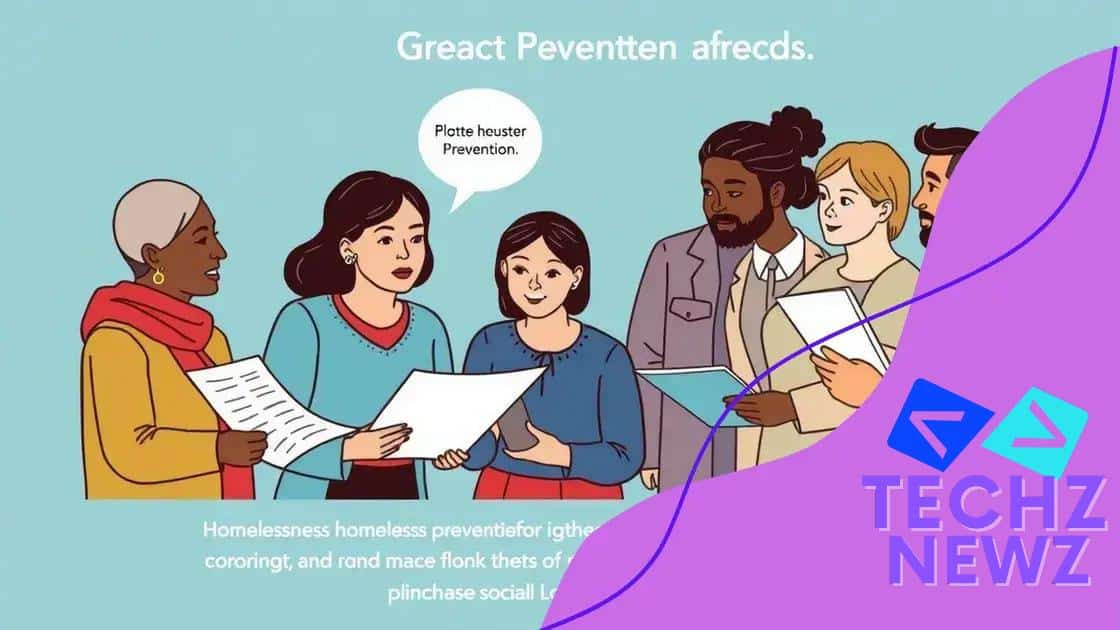Homelessness prevention programs and initiatives that work

Homelessness prevention programs and initiatives provide essential resources, support, and collaborative efforts to help individuals maintain stable housing and avoid the crisis of homelessness.
Homelessness prevention programs and initiatives play a crucial role in addressing this pressing issue. Have you ever wondered what truly makes these programs effective? Let’s dive into some successful strategies.
Understanding homelessness prevention programs
Understanding homelessness prevention programs is essential for tackling one of society’s most pressing challenges. These programs aim to provide support and resources to individuals at risk of losing their homes, ensuring that they can maintain stability and avoid the crisis of homelessness.
Types of Prevention Programs
Different types of programs cater to specific needs within the community. Some focus on immediate assistance, while others address underlying issues. It’s important to recognize the variety of approaches to effectively prevent homelessness.
- Emergency financial assistance
- Legal aid for tenants facing eviction
- Case management services
- Support for mental health and addiction problems
These elements are crucial in creating a supportive environment. By addressing financial struggles and social factors, programs can effectively reduce the number of people sliding into homelessness.
The Role of Community Support
Moreover, community collaboration plays a significant role in the success of these initiatives. Local organizations, government agencies, and volunteers can come together to provide a unified support system. This synergy ensures that resources are pooled together for optimal impact.
Involving local businesses in these efforts can also be beneficial. They can provide job opportunities and stability for individuals at risk. By focusing on both prevention and recovery, we create a healthier community altogether.
Measuring Success
To ensure that homelessness prevention programs are effective, it’s vital to have measurable outcomes. By tracking progress, communities can understand which strategies work best and refine their approaches over time.
- Tracking the number of prevented evictions
- Analyzing sustained housing stability
- Evaluating participant feedback
Ultimately, understanding the diverse aspects of these programs reveals their critical importance. They not only help individuals find safe housing but also contribute to healthier, more resilient communities.
Key initiatives changing lives
Key initiatives changing lives can have a profound impact on those at risk of homelessness. Various programs focus on different aspects of prevention, making it essential to understand what works best.
Job Training Programs
One important initiative is job training programs. They equip individuals with the skills necessary to find stable employment. This stability is crucial for maintaining housing. Participants often learn about resume writing and interview techniques, which enhance their chances of securing a job.
- Hands-on experience through internships
- Workshops on effective job searching
- Support from career counselors
With access to these resources, participants can build confidence and find meaningful employment.
Affordable Housing Projects
Another significant initiative is the development of affordable housing projects. These projects aim to create safe and stable environments for individuals and families. By providing access to housing that is affordable, it directly addresses a key factor that contributes to homelessness.
Many communities have partnered with local governments to create these projects. This collaboration ensures the successful delivery of housing services to those in need. Programs often include financial assistance to help residents stay in their homes.
Supportive Services
While housing is vital, supportive services are also crucial for long-term success. Programs that offer mental health support, addiction recovery, and family counseling can significantly aid those in crisis. These services address root causes and empower individuals to overcome their challenges.
- Access to counseling sessions
- Substance abuse treatment programs
- Parenting classes and family support
With a comprehensive approach, these initiatives work together to change lives. By focusing on both immediate needs and long-term solutions, communities can make strides in preventing homelessness and supporting those at risk.
Collaborative approaches for success

Collaborative approaches for success in preventing homelessness can lead to more effective outcomes. By working together, various stakeholders in the community can bring unique resources and perspectives to the table.
Building Partnerships
One crucial aspect of collaboration is building strong partnerships. Government agencies, non-profits, and local businesses can unite to form a network that supports vulnerable populations. When organizations combine their efforts, they can create comprehensive solutions that address the multiple facets of homelessness.
- Sharing resources and information
- Coordinating events and outreach efforts
- Creating joint funding applications for grants
This type of teamwork maximizes impact and helps to ensure that individuals receive well-rounded support. Strengthening partnerships can enhance trust and establish a solid foundation for future initiatives.
Engaging the Community
Engaging the community is also vital in collaborative efforts. Local residents often know the challenges faced by their neighbors. By involving them in decision-making processes, programs can become more tailored to the community’s needs. This grassroots approach ensures that initiatives resonate with those they aim to help and often leads to higher participation rates.
Furthermore, community involvement can empower individuals to take ownership of local solutions. Encouraging volunteers to participate in outreach or support services can foster a sense of belonging, which is essential for building strong neighborhoods.
Data-Driven Decision Making
Another crucial element in collaborative approaches is utilizing data-driven decision-making. By collecting and analyzing data, communities can identify trends and gaps in services. This data can help determine where resources are most needed, allowing for targeted interventions that are more likely to succeed.
- Tracking rates of homelessness in specific areas
- Evaluating the effectiveness of current programs
- Using feedback to inform future initiatives
Through collaboration, communities can engage in continuous improvement. By sharing results and strategies, they can adapt their methods to ensure greater success in preventing homelessness.
Community involvement in prevention efforts
Community involvement in prevention efforts is crucial for effectively combating homelessness. When local residents actively participate, the solutions become more tailored and impactful.
Ways to Get Involved
Communities can engage in various initiatives that directly contribute to prevention. Volunteer opportunities abound, allowing people to play an active role in making a difference. Simple actions can lead to meaningful change.
- Organizing food drives for families in need
- Participating in outreach programs to connect with at-risk individuals
- Hosting workshops to educate the community about housing resources
These initiatives create a sense of unity and demonstrate that the fight against homelessness is a collective effort. When community members come together, they can accomplish much more than any single individual or organization.
Building Awareness
Another vital aspect of community involvement is raising awareness about homelessness. Educating the public can challenge stereotypes and misconceptions. Awareness initiatives may include community presentations, social media campaigns, and local events.
By sharing stories of those who have experienced homelessness, communities can foster empathy. This understanding not only encourages support but also empowers individuals to take action.
Collaborative Events
Furthermore, organizing collaborative events can strengthen community ties. Events like neighborhood clean-ups and charity runs can draw people together under a common goal. This fosters teamwork while raising funds and resources for local homelessness prevention programs.
- Planning community health fairs with access to resources
- Coordinating fundraising events for local shelters
- Creating mentorship programs for youth at risk
When everyone plays a part in the effort, it sends a powerful message that homelessness is a community problem requiring a community solution. Together, communities can create lasting change that benefits everyone.
Measuring effectiveness in prevention programs
Measuring effectiveness in prevention programs is crucial to understanding how well these initiatives work. By tracking outcomes, communities can assess what is successful and determine areas for improvement.
Data Collection Methods
One way to measure effectiveness is through data collection. Programs often use surveys and reports to gather information on participant experiences. This data can reveal how many individuals successfully avoided homelessness due to program intervention.
- Conducting pre- and post-program surveys
- Monitoring housing stability rates
- Tracking employment status of participants
These methods provide valuable insights that help organizations adjust their strategies based on real information.
Setting Benchmarks
Establishing benchmarks is another critical aspect of measuring effectiveness. By setting specific goals, programs can track their progress over time. For example, if a program aims to reduce the eviction rate by 20% within a year, it can measure its success against this target.
These benchmarks create accountability and motivation for organizations. They can also engage community members by showing them the tangible impacts of local initiatives.
Impact Assessment
Ultimately, assessing the impact of prevention programs requires a thorough evaluation process. This includes analyzing both quantitative and qualitative data. Understanding how a program has transformed the lives of individuals provides a fuller picture of its effectiveness.
- Reviewing success stories from program participants
- Analyzing demographic trends among those served
- Collecting feedback from community stakeholders
By continuously measuring effectiveness, prevention programs can adapt and grow. This responsiveness ensures that they meet the needs of the community and effectively combat homelessness.
FAQ – Frequently Asked Questions about Homelessness Prevention Programs
What are homelessness prevention programs?
Homelessness prevention programs are initiatives designed to provide support and resources to individuals at risk of losing their homes, aiming to keep them stable.
How can community involvement help in preventing homelessness?
Community involvement fosters collaboration and support for those at risk, ensuring localized and effective solutions to homelessness.
What methods are used to measure the effectiveness of prevention programs?
Programs often use surveys, data tracking, and benchmarks to assess their performance and make necessary adjustments for improvement.
Why is collaboration important in combating homelessness?
Collaboration allows organizations and communities to combine resources, share knowledge, and create a more comprehensive approach to preventing homelessness.





